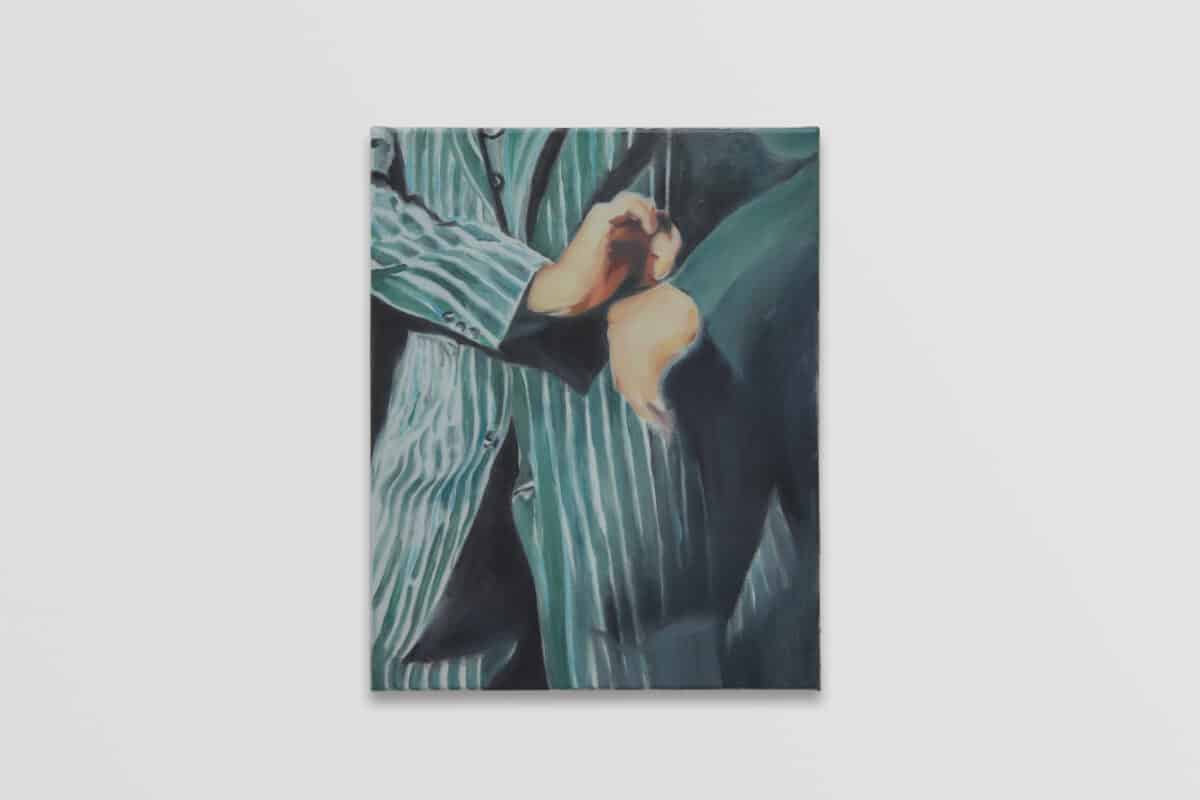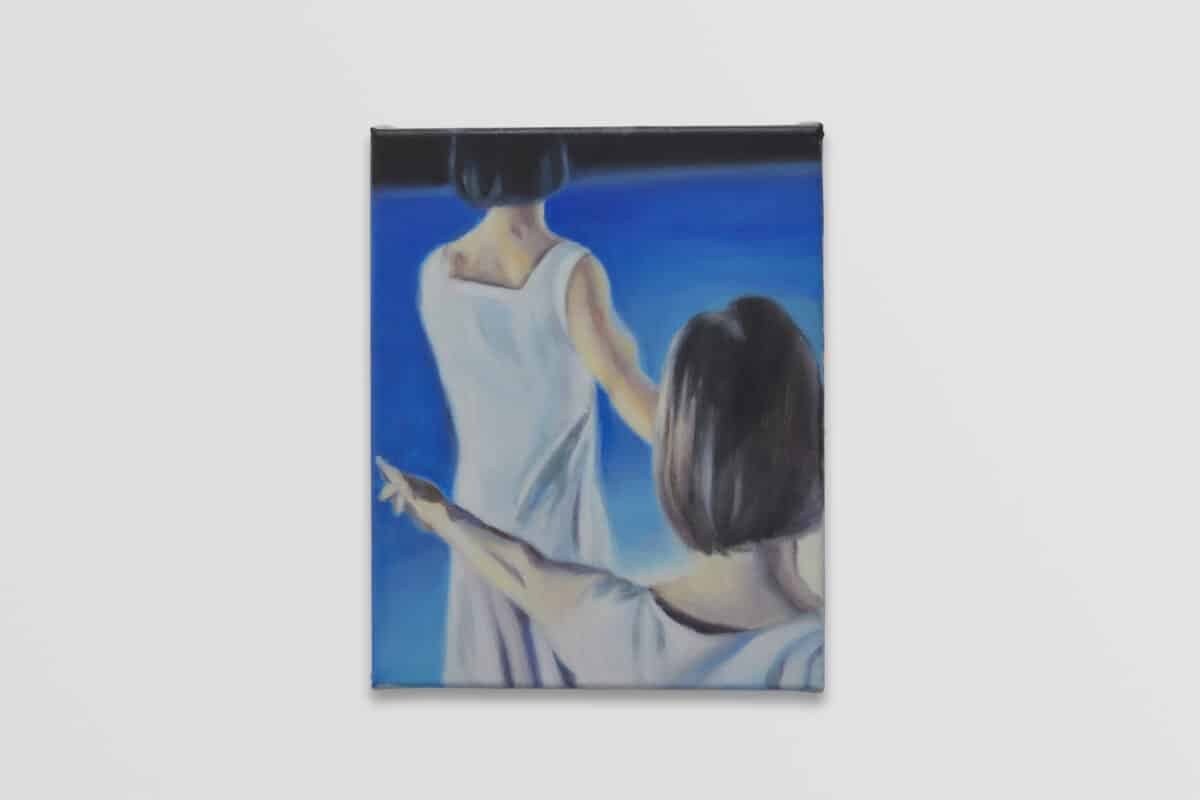
A single note played on a piano, the sudden turn of a dancer’s head, the artist’s finger pressing pause on a remote control. The interplay of intent and freedom characterises Les Mains Libres, a recent series of paintings by the French artist Claire Fahys. Drawing inspiration from contemporary choreography, Fahys creates a paradox in paint. She places the fleeting moment centre stage, taking her subjects from video performances of works by prominent twentieth and twenty-first-century choreographers, among them Anne Teresa de Keersmaeker, Pina Bausch and Léo Walk. The paintings are a serenade to the spontaneity of dance; they elongate the ephemeral so that when one stands in front of them, time becomes elastic.
It is, however, this temporal elasticity that grounds the viewer, who remains safe in the knowledge of their own body. The title of the series is taken from a 1937 poem by Paul Éluard (1895–1952) and acknowledges the debt of liberty to industrious creativity. For each oil painting, Fahys worked from a series of screenshots taken instinctively while watching recorded performances. This creates a mode of separation between subject and artist:
‘the more distance you have from a subject, the better, especially at the beginning of the process. My process incorporates this lack of control. It is organic. Change and unpredictability brings you closer to the depth and essence’
she says.
This unpredictability results in a depth of textures across the series, the brushstrokes confidently switching from blurry dancers’ profiles to a sharply articulated ankle in arabesque.
The beat of the drums that were the focus of her last series of works, Tempo (exhibited at Better Go South Gallery, Stuttgart, earlier this year), finds an echo here. The Tempo canvases were unified by their subject and the beat that seemed to resonate from each. By contrast, the works in Les Mains Libres are unified by the rhythm that moves across and between the surfaces of each work. Around twenty small and medium-sized canvases are displayed together on the main wall.

One dancer’s popped shoulder finds its accompanying flicked wrist two canvases away; the flowing folds of a blue skirt in one canvas is echoed in the mysterious drapery that surrounds a static figure on the opposite wall. The hang is purposefully tight, creating a palpable sense of the pre-performance jitters and dressing room adrenaline. The joy and energy of these works collectively is instantaneous and immediate, and yet the series also invites concentrated, fractional looking. Fahys asks the viewer to engage with her medium, layering up washes of paint with blended lines and more defined strokes, each painting a dynamic tableau vivant in its own right.
Although each considered composition captures the boundless intensity of movement, it is only in their relationship to one another that a new dynamism is realised. Fahys at once expands our conception of painting’s limitations and strives to blur the established demarcations between art’s formal qualities and its pedagogical potential.

As a series, Les Mains Libres captures the essence of dance, yet through an in-depth exploration of the individual moment. In a choreographed piece of dance, each individual moment will have been rehearsed, over and over again, achieving control through repetition, but a control that ultimately facilitates uninhibited expression. Fahys captures this dichotomy with her own controlled palette of blues and ochres, the paintings retain a focus on the formal, and the translucency of the paint adds to their sense of fleetingness.
In fin-de-siècle Paris, dance in its many iterations mirrored French social fabric. From the opera and ballet of the upper classes, down to the all-night revelry at the Moulin Rouge, the allure of the stage provided a great source of inspiration to artists. As the new dominant mode of visual expression, Impressionism
unequivocally captured the verve and energy of the city. The evocation of dance in paint yielded some of the greatest and most loved works of art in the Western canon, from Edgar Degas’s sensitive pastels of ballet dancers to Henri de Toulouse Lautrec’s depictions of riotous cancan girls.
As a native Parisienne, the Impressionist works of the stage are a personal touchstone for Fahys. But it is the influence of the later paintings of Henri Matisse that finds its expression most poignantly in Les Mains Libres. The iconic blue of Matisse’s collage nudes is discernible in Fahys’s palette, as are their corporeal creases: folded elbows, bent knees and angled wrists. The bodies are merely floating painted and pasted paper, but they have weight like Fahys’s figures. Matisse’s painting La Danse I (1909; MoMA) arguably represents the apex of this concern with moving bodies in space. The simple colours of the gambolling naked dancers convey the quiet joy of being in nature, while creating spatial ambiguity that underscores the physicality of the painted surface. One of the dancer’s feet drifts off the bottom of the canvas, drawing the viewer in to the scene, while the two dancers at the top of the canvas have to bow their heads so as not to be cropped off by the frame. Likewise, Fahys invites us to share in the rhythm of her protagonists, and simultaneously makes us aware of her hand.
The modern city also yields sources of inspiration for Fahys – breaking (or breakdancing), for example, has resurged in popularity in recent years, so much so that it has been chosen as a new sport for the Paris 2024 Olympic Games. Over the last couple of years, Fahys has become more interested in young dancers who choreograph and perform their own shows on the streets of Paris and in non-traditional venues around the city. This fresh energy is manifest in Les Mains Libres, in particular, but it has been a concern in both her previous series of paintings. Rodéo was a group of paintings of bikers exhibited at Galerie Hussenot in Paris in 2022. Fahys considered the moves these young men were making on the motor-cross bikes as a kind of choreography and the virtuosity of their poses certainly find an echo in this latest series. Rodéo closed with a performance by two dancers graduating from the Conservatoire National Supérieur de Musique et de Danse, responding to the shapes, tensions and synergies of the bikers. Fahys is consciously working at the intersection of dance, music and paint, and this sensitivity to the active and reactive human body has directed her recent practice.
Combining art historical references with contemporary sources of inspiration makes Les Mains Libres urgent and current. The blended language Fahys employs is emotionally moving and conceptually complex, but crucially imbues the canvases with life and energy. Perhaps this is most apparent in a portrait – the only one in the series: a dancer in blue, cheeks rosy and brow furrowed from the effort. Caught mid-breath, arms en avant, at her most alive; she is at once anonymous and all of us.
Words Sarah Bolwell @sarah_bolwell
Claire Fahys, Les Mains Libres, 7th June – 9th Jun, The Library at The Laslett, 8 Pembridge Gardens, W2 4DU Private view: Tuesday 6th June 5-8PM
Curated by Tatiana Roth @tatianaroth_art
About the artist
Claire Fahys (b.1984) was born in Paris, France, and is based in Paris. She studied Art History at the Sorbonne (2003), then a foundation course at Ateliers de Sèvres (2004) in Paris. She completed a BA in Graphic design at Central Saint Martins School of Art and Design (2007). Recent exhibitions include a group show, Tempo (2023), at Better Go South Gallery, Stuttgart/Berlin; The Power To Dream (2023) at Galerie Hussenot, Paris; and a solo show, Rodéo (2022), at Galerie Hussenot, Paris.









